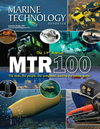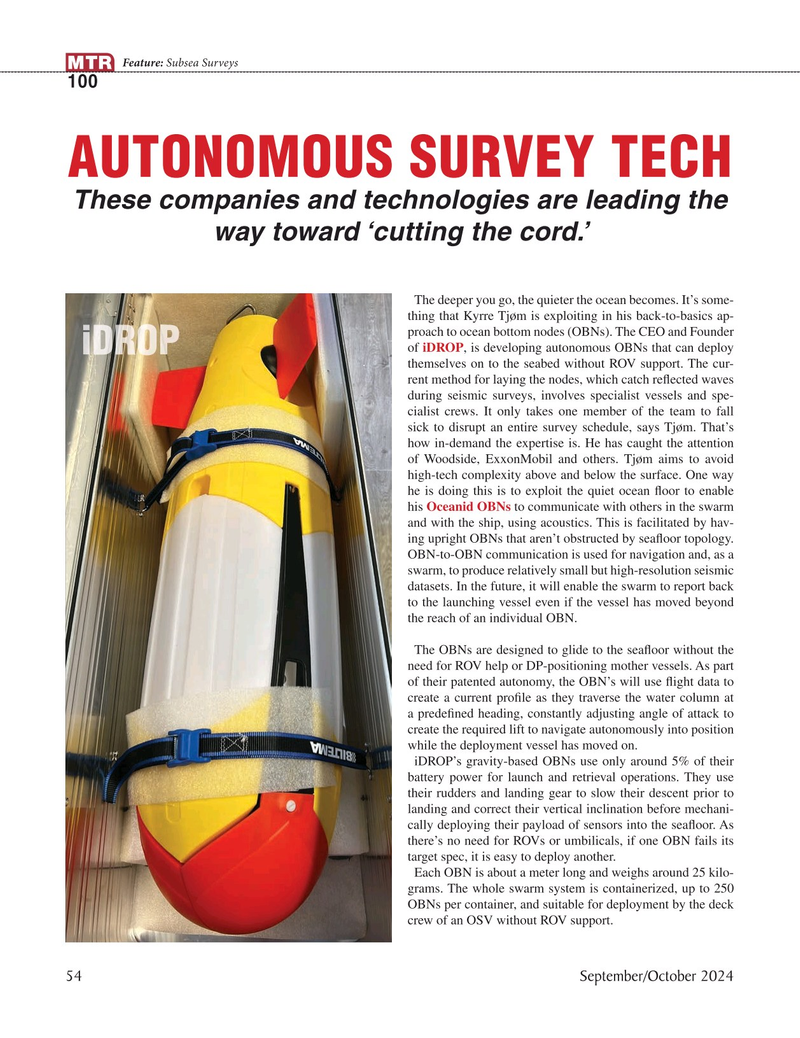
Page 54: of Marine Technology Magazine (September 2024)
Read this page in Pdf, Flash or Html5 edition of September 2024 Marine Technology Magazine
Feature: Subsea Surveys
MTR 100
AUTONOMOUS SURVEY TECH
These companies and technologies are leading the way toward ‘cutting the cord.’
The deeper you go, the quieter the ocean becomes. It’s some- thing that Kyrre Tjøm is exploiting in his back-to-basics ap- proach to ocean bottom nodes (OBNs). The CEO and Founder of iDROP, is developing autonomous OBNs that can deploy themselves on to the seabed without ROV support. The cur- rent method for laying the nodes, which catch re? ected waves during seismic surveys, involves specialist vessels and spe- cialist crews. It only takes one member of the team to fall sick to disrupt an entire survey schedule, says Tjøm. That’s how in-demand the expertise is. He has caught the attention of Woodside, ExxonMobil and others. Tjøm aims to avoid high-tech complexity above and below the surface. One way he is doing this is to exploit the quiet ocean ? oor to enable his Oceanid OBNs to communicate with others in the swarm and with the ship, using acoustics. This is facilitated by hav- ing upright OBNs that aren’t obstructed by sea? oor topology.
OBN-to-OBN communication is used for navigation and, as a swarm, to produce relatively small but high-resolution seismic datasets. In the future, it will enable the swarm to report back to the launching vessel even if the vessel has moved beyond the reach of an individual OBN.
The OBNs are designed to glide to the sea? oor without the need for ROV help or DP-positioning mother vessels. As part of their patented autonomy, the OBN’s will use ? ight data to create a current pro? le as they traverse the water column at a prede? ned heading, constantly adjusting angle of attack to create the required lift to navigate autonomously into position while the deployment vessel has moved on.
iDROP’s gravity-based OBNs use only around 5% of their battery power for launch and retrieval operations. They use their rudders and landing gear to slow their descent prior to landing and correct their vertical inclination before mechani- cally deploying their payload of sensors into the sea? oor. As there’s no need for ROVs or umbilicals, if one OBN fails its target spec, it is easy to deploy another.
Each OBN is about a meter long and weighs around 25 kilo- grams. The whole swarm system is containerized, up to 250
OBNs per container, and suitable for deployment by the deck crew of an OSV without ROV support. 54 September/October 2024
MTR #7 (50-65).indd 54 10/3/2024 11:52:38 AM

 53
53

 55
55
